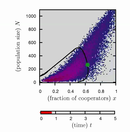The dilemma of cooperation in growing populations
This movie illustrates the asymmetric amplification of fluctuations leading to a transient increase in cooperation.
Consider an ensemble of small populations, each with the same initial size and the same initial fraction of cooperators. Then, in the initial phase of the dynamics, stochastic fluctuations are large and create a rather broad distribution of population compositions. Since more cooperative populations, i. e. populations with a higher fraction of cooperators, have a larger growth rate these fluctuations are amplified asymmetrically such that the probability distribution become skewed towards more cooperative populations. Since with growing population sizes the magnitude of stochastic fluctuations decreases, it is mainly the initial phase of the dynamics which sets the overall width of the probability distribution. The time evolution following the initial “noisy period” deforms and shifts this distribution. Deformation arises, as discussed, mainly due to the dependence of the growth-rate on the cooperator fraction. The probability distribution is finally shifted towards smaller mean values due to the selection pressure within each population which disfavors cooperators.


